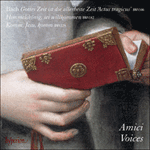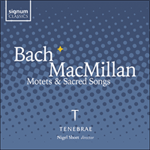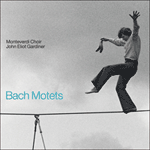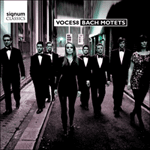The eight-part
Komm, Jesu, komm is steeped in seventeenth-century tradition. The text, a paraphrase of John 14, verse 6 (‘I am the way, the truth and the life: no man cometh unto the Father but by me’) was written by the Leipzig poet Paul Thymich, and was originally set by Johann Schelle, a predecessor of Bach at St Thomas’s, for the funeral of Rector Jakob Thomasius on 14 September 1684; the occasion for which Bach set the text is not known. Schelle’s work, a simple aria, was later published, and it was probably from this source that Bach took the text, though the settings are unrelated. Bach uses the first and last verses of Thymich’s poem; the first is set in the traditional polychoral motet style, with several changes of time and pace; the second is headed ‘Aria’ and is a simple four-part setting of a minuet-like melody that seems to be by Bach himself—it is not unlike his best-known chorale, ‘Dir, dir, Jehova, will ich singen’.
from notes by Peter Holman © 1990
Le motet à huit parties
Komm, Jesu, komm s’enracine dans la tradition du XVIIe siècle. Le texte, une paraphrase du verset 6 de Jean 14 («Je suis le chemin, la vérité et la vie: nul ne vient au Père que par moi»), fut rédigé par le poète lipsien Paul Thymich et originellement mis en musique par Johann Schelle, un prédécesseur de Bach à Saint-Thomas, pour les funérailles du recteur Jakob Thomasius, le 14 septembre 1684; on ignore pour quelle occasion Bach le mit en musique. L’œuvre de Schelle, une simple aria, fut publiée plus tard et ce fut probablement à cette source que Bach emprunta le texte, même si les deux mises en musique n’ont rien à voir. Bach utilise les premières et dernières strophes du poème de Thymich: la première est exprimée dans le style traditionnel du motet polychoral, avec plusieurs changements de mesure et de tempo; la seconde, intitulée «Aria», est une simple mise en musique à quatre parties d’une mélodie façon menuet qui semble être de Bach lui-même—elle n’est pas sans rappeler son célèbre choral «Dir, dir, Jehova, will ich singen».
extrait des notes rédigées par Peter Holman © 1990
Français: Hypérion
Die achtstimmige Motette
Komm, Jesu, komm entstammt der Tradition des 17. Jahrhunderts. Der Text ist eine Paraphrase nach Johannes 14, 6 und stammt von dem Leipziger Dichter Paul Thymich und war ursprünglich von dem Thomaskantor Johann Schelle für das Begräbnis des Rektors der Thomasschule Jakob Thomasius am 14. September 1684 komponiert worden; der Anlass für Bachs Vertonung ist nicht bekannt. Schelles Werk, eine schlichte Arie, wurde später veröffentlicht, und wahrscheinlich war dies die Quelle, die Bach den Text lieferte, obwohl die beiden Vertonungen sonst keine Parallelen zueinander aufweisen. Bach verwendet die erste und letzte Strophe von Thymichs Gedicht; die erste ist im traditionsgemäßen mehrchörigen Motettenstil angelegt, wobei mehrere Tempo- und Taktwechsel stattfinden, und die zweite trägt die Überschrift „Aria“ und ist eine schlichte vierstimmige Vertonung einer menuettartigen Melodie, die von Bach selbst zu stammen scheint—sie ist seinem berühmtesten Choral, „Dir, dir, Jehova, will ich singen“, nicht unähnlich.
aus dem Begleittext von Peter Holman © 1990
Deutsch: Viola Scheffel


 Bach: Cantatas Nos 106 & 182
Bach: Cantatas Nos 106 & 182 Bach & MacMillan: Motets & Sacred Songs
Bach & MacMillan: Motets & Sacred Songs Bach: Motets
Bach: Motets Bach: Motets
Bach: Motets
